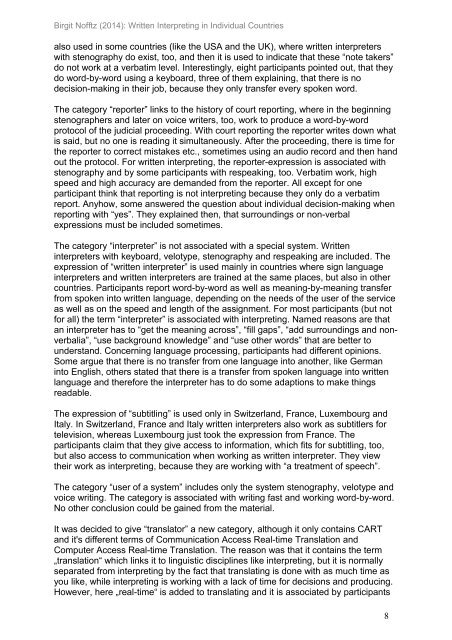Written_interpreting_in_individual_countries_Birgit_Nofftz(2014)
Written_interpreting_in_individual_countries_Birgit_Nofftz(2014)
Written_interpreting_in_individual_countries_Birgit_Nofftz(2014)
You also want an ePaper? Increase the reach of your titles
YUMPU automatically turns print PDFs into web optimized ePapers that Google loves.
<strong>Birgit</strong> <strong>Nofftz</strong> (<strong>2014</strong>): <strong>Written</strong> Interpret<strong>in</strong>g <strong>in</strong> Individual Countries<br />
also used <strong>in</strong> some <strong>countries</strong> (like the USA and the UK), where written <strong>in</strong>terpreters<br />
with stenography do exist, too, and then it is used to <strong>in</strong>dicate that these “note takers”<br />
do not work at a verbatim level. Interest<strong>in</strong>gly, eight participants po<strong>in</strong>ted out, that they<br />
do word-by-word us<strong>in</strong>g a keyboard, three of them expla<strong>in</strong><strong>in</strong>g, that there is no<br />
decision-mak<strong>in</strong>g <strong>in</strong> their job, because they only transfer every spoken word.<br />
The category “reporter” l<strong>in</strong>ks to the history of court report<strong>in</strong>g, where <strong>in</strong> the beg<strong>in</strong>n<strong>in</strong>g<br />
stenographers and later on voice writers, too, work to produce a word-by-word<br />
protocol of the judicial proceed<strong>in</strong>g. With court report<strong>in</strong>g the reporter writes down what<br />
is said, but no one is read<strong>in</strong>g it simultaneously. After the proceed<strong>in</strong>g, there is time for<br />
the reporter to correct mistakes etc., sometimes us<strong>in</strong>g an audio record and then hand<br />
out the protocol. For written <strong><strong>in</strong>terpret<strong>in</strong>g</strong>, the reporter-expression is associated with<br />
stenography and by some participants with respeak<strong>in</strong>g, too. Verbatim work, high<br />
speed and high accuracy are demanded from the reporter. All except for one<br />
participant th<strong>in</strong>k that report<strong>in</strong>g is not <strong><strong>in</strong>terpret<strong>in</strong>g</strong> because they only do a verbatim<br />
report. Anyhow, some answered the question about <strong>in</strong>dividual decision-mak<strong>in</strong>g when<br />
report<strong>in</strong>g with “yes”. They expla<strong>in</strong>ed then, that surround<strong>in</strong>gs or non-verbal<br />
expressions must be <strong>in</strong>cluded sometimes.<br />
The category “<strong>in</strong>terpreter” is not associated with a special system. <strong>Written</strong><br />
<strong>in</strong>terpreters with keyboard, velotype, stenography and respeak<strong>in</strong>g are <strong>in</strong>cluded. The<br />
expression of “written <strong>in</strong>terpreter” is used ma<strong>in</strong>ly <strong>in</strong> <strong>countries</strong> where sign language<br />
<strong>in</strong>terpreters and written <strong>in</strong>terpreters are tra<strong>in</strong>ed at the same places, but also <strong>in</strong> other<br />
<strong>countries</strong>. Participants report word-by-word as well as mean<strong>in</strong>g-by-mean<strong>in</strong>g transfer<br />
from spoken <strong>in</strong>to written language, depend<strong>in</strong>g on the needs of the user of the service<br />
as well as on the speed and length of the assignment. For most participants (but not<br />
for all) the term “<strong>in</strong>terpreter” is associated with <strong><strong>in</strong>terpret<strong>in</strong>g</strong>. Named reasons are that<br />
an <strong>in</strong>terpreter has to “get the mean<strong>in</strong>g across”, “fill gaps”, “add surround<strong>in</strong>gs and nonverbalia”,<br />
“use background knowledge” and “use other words” that are better to<br />
understand. Concern<strong>in</strong>g language process<strong>in</strong>g, participants had different op<strong>in</strong>ions.<br />
Some argue that there is no transfer from one language <strong>in</strong>to another, like German<br />
<strong>in</strong>to English, others stated that there is a transfer from spoken language <strong>in</strong>to written<br />
language and therefore the <strong>in</strong>terpreter has to do some adaptions to make th<strong>in</strong>gs<br />
readable.<br />
The expression of “subtitl<strong>in</strong>g” is used only <strong>in</strong> Switzerland, France, Luxembourg and<br />
Italy. In Switzerland, France and Italy written <strong>in</strong>terpreters also work as subtitlers for<br />
television, whereas Luxembourg just took the expression from France. The<br />
participants claim that they give access to <strong>in</strong>formation, which fits for subtitl<strong>in</strong>g, too,<br />
but also access to communication when work<strong>in</strong>g as written <strong>in</strong>terpreter. They view<br />
their work as <strong><strong>in</strong>terpret<strong>in</strong>g</strong>, because they are work<strong>in</strong>g with “a treatment of speech”.<br />
The category “user of a system” <strong>in</strong>cludes only the system stenography, velotype and<br />
voice writ<strong>in</strong>g. The category is associated with writ<strong>in</strong>g fast and work<strong>in</strong>g word-by-word.<br />
No other conclusion could be ga<strong>in</strong>ed from the material.<br />
It was decided to give “translator” a new category, although it only conta<strong>in</strong>s CART<br />
and it's different terms of Communication Access Real-time Translation and<br />
Computer Access Real-time Translation. The reason was that it conta<strong>in</strong>s the term<br />
„translation“ which l<strong>in</strong>ks it to l<strong>in</strong>guistic discipl<strong>in</strong>es like <strong><strong>in</strong>terpret<strong>in</strong>g</strong>, but it is normally<br />
separated from <strong><strong>in</strong>terpret<strong>in</strong>g</strong> by the fact that translat<strong>in</strong>g is done with as much time as<br />
you like, while <strong><strong>in</strong>terpret<strong>in</strong>g</strong> is work<strong>in</strong>g with a lack of time for decisions and produc<strong>in</strong>g.<br />
However, here „real-time“ is added to translat<strong>in</strong>g and it is associated by participants<br />
8


